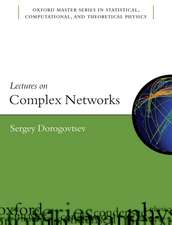Computational Statistical Physics: From Billiards to Monte Carlo
Editat de K.-H. Hoffmann, Michael Schreiberen Limba Engleză Hardback – 23 oct 2001
| Toate formatele și edițiile | Preț | Express |
|---|---|---|
| Paperback (1) | 641.53 lei 6-8 săpt. | |
| Springer Berlin, Heidelberg – 3 dec 2010 | 641.53 lei 6-8 săpt. | |
| Hardback (1) | 647.92 lei 6-8 săpt. | |
| Springer Berlin, Heidelberg – 23 oct 2001 | 647.92 lei 6-8 săpt. |
Preț: 647.92 lei
Preț vechi: 762.26 lei
-15% Nou
Puncte Express: 972
Preț estimativ în valută:
123.100€ • 128.97$ • 102.37£
123.100€ • 128.97$ • 102.37£
Carte tipărită la comandă
Livrare economică 15-29 aprilie
Preluare comenzi: 021 569.72.76
Specificații
ISBN-13: 9783540421603
ISBN-10: 3540421602
Pagini: 322
Ilustrații: XV, 300 p.
Dimensiuni: 155 x 235 x 25 mm
Greutate: 0.63 kg
Ediția:2002
Editura: Springer Berlin, Heidelberg
Colecția Springer
Locul publicării:Berlin, Heidelberg, Germany
ISBN-10: 3540421602
Pagini: 322
Ilustrații: XV, 300 p.
Dimensiuni: 155 x 235 x 25 mm
Greutate: 0.63 kg
Ediția:2002
Editura: Springer Berlin, Heidelberg
Colecția Springer
Locul publicării:Berlin, Heidelberg, Germany
Public țintă
ResearchCuprins
1 Game Theory and Statistical Mechanics.- 2 Chaotic Billiards.- 3 Combinatorial Optimization and High Dimensional Billiards.- 4 The Statistical Physics of Energy Landscapes: From Spin Glasses to Optimization.- 5 Optimization of Production Lines by Methods from Statistical Physics.- 6 Predicting and Generating Time Series by Neural Networks: An Investigation Using Statistical Physics.- 7 Statistical Physics of Cellular Automata Models for Traffic Flow.- 8 Self-Organized Criticality in Forest-Fire Models.- 9 Nonlinear Dynamics of Active Brownian Particles.- 10 Financial Time Series and Statistical Mechanics.- 11 ‘Go with the Winners’ Simulations.- 12 Aperiodicity and Disorder — Do They Play a Role?.- 13 Quantum Phase Transitions.- 14 Introduction to Energy Level Statistics.- 15 Randomness in Optical Spectra of Semiconductor Nanostructures.- 16 Characterization of the Metal—Insulator Transition in the Anderson Model of Localization.- 17 Percolation, Renormalization and Quantum Hall Transition.
Recenzii
From the reviews of the first edition:
"This book contains 17 chapters devoted to the use of statistical mechanical methods in areas not belonging to physics and also a few which do belong to physics. Each chapter is a nicely written tutorial presentation of the problem and of the numerical techniques used to solve it. … Each of these chapters can be used as a concise introduction … ." (M. Baus, Physicalia, Issue 6, 2002)
"This book is a different style of computational physics text, rather more like the conference proceedings than the usual undergraduate text. … The result then is quite a pleasing survey of current topics in computational statistical physics. … For the lecturer this is a very attractive resource for project length problems in a computational physics course for higher undergraduate or early graduate level students. For graduate students it is a good survey of modern statistical physics problems that lend themselves to numerical treatment." (G. P. Morriss, The Physicist, Vol. 39 (3), 2002)
"This book contains 17 chapters devoted to the use of statistical mechanical methods in areas not belonging to physics and also a few which do belong to physics. Each chapter is a nicely written tutorial presentation of the problem and of the numerical techniques used to solve it. … Each of these chapters can be used as a concise introduction … ." (M. Baus, Physicalia, Issue 6, 2002)
"This book is a different style of computational physics text, rather more like the conference proceedings than the usual undergraduate text. … The result then is quite a pleasing survey of current topics in computational statistical physics. … For the lecturer this is a very attractive resource for project length problems in a computational physics course for higher undergraduate or early graduate level students. For graduate students it is a good survey of modern statistical physics problems that lend themselves to numerical treatment." (G. P. Morriss, The Physicist, Vol. 39 (3), 2002)
Textul de pe ultima copertă
In recent years statistical physics has made significant progress as a result of advances in numerical techniques. While good textbooks exist on the general aspects of statistical physics, the numerical methods and the new developments based on large-scale computing are not usually adequately presented. In this book 16 experts describe the application of methods of statistical physics to various areas in physics: disordered materials, quasicrystals, semiconductors, ... and also to other areas beyond physics, such as financial markets, game theory, evolution, and traffic planning, in which statistical physics has recently become significant. In this way the universality of the underlying concepts and methods such as fractals, random matrix theory, time series, neural networks, evolutionary algorithms, becomes clear. The topics are covered by introductory, tutorial presentations.
Caracteristici
Illustrates how advances in numerical computing have contributed to progress in many areas of statistical physics and beyond (e.g. financial theory, evolution, traffic planning) Contains up-to-date tutorial contributions by 16 experts Includes supplementary material: sn.pub/extras















